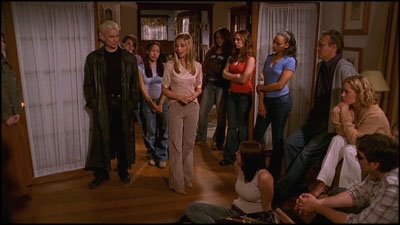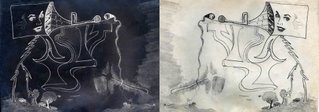 |
| Former villain Spike, Buffy and the Potentials |
For all of the wonders of science, and the inescapable fact that we owe virtually every convenience of our modern lives to scientific endeavor, we fear the future. After all, science has given us a means to annihilation at the very basis of matter—the atom. We first saw the horrific potential of this invisible speck of science in Hiroshima and Nagasaki but later saw more insidious dangers with the threatened meltdown of Three Mile Island and the disaster that played itself out at Chernobyl. The threats of genetically engineered disease and military strains of anthrax captured the science fiction imagination even before those menacing envelopes of white powder that appeared after September 11, 2001. Dr. Frankenstein and his monster are legion in both our reality and our imagination.
Similarly, we also fear our scientific efforts to improve society. In a world that has not only witnessed the horrors of Nazi eugenics experiments and genocide but also the syphilis experiments secretly conducted on Blacks in the United States, it is easy to see why. Big Brother is alive and well in a country that passed the Patriot Act, which allows for heightened surveillance and arrest of those suspected of being political enemies of the United States. The average American’s behavior is photographed and recorded innumerable times each day. We would be crazy to not be afraid of the abuse of such technology.
 |
| Duel, 1971 |
Countless science fiction stories feature technology gone mad—as with the robotic futures of
The Terminator and
The Matrix movies as well as the biological terrors of
The Stand and
Cabin Fever. We also fear the effects such technological advances are having on our psyches. The angry truck drivers of
Duel and
Joy Ride embody our fears of, and our own feelings of, road rage. The mindless mallwalkers in both versions of
Dawn of the Dead embody our consumerist complacency. It says something that
Invasion of the Bodysnatchers has often been interpreted as a metaphor for Stalinist repression of the individual while director Don Siegel has said he was thinking more about the uniformity of the American consumer society. The fact that the 1956 story has been remade in 1978, 1993 and 2006 (as
The Visiting) says something about how Siegel’s conception of the idea holds up. Movies like
The Stepford Wives,
They Live and even the
Matrix trilogy offer different takes on the same fear of loss of individuality. We fear an unsane future, whether it be in the violence loving society or its inhuman antidote in
A Clockwork Orange.
 |
| Dawn of the Dead, 1978 |
Along with our fear of insanity, science fiction offers some variation on all of our fears. The Frankenstein monster becomes HAL of
2001: A Space Odyssey and the replicants of
Blade Runner. Vampires take over the Earth in Richard Matheson’s
I Am Legend and
The Omega Man. Our inner wolf is unleashed in the insanity of the rageaholic zombies of
28 Days Later. Not all sci fi but kindred, the new gothic heroines of
Resident Evil,
Underworld and
Buffy the Vampire Slayer face all of these monsters and the infinite variety of madness, helplessness and alienation that causes them and is caused by them.
The future is the place where horror and science fiction become all but indistinguishable, but there are important common denominators in the vision. Science fiction horror is, in the main, a world of repressive order (dystopia) or a world of chaos. The great fear that connects these two visions lies in a distrust of human nature. We don’t trust our own ability to deal with what's coming our way.
What we expect and most fear about the future is a time of reckoning. We are afraid of that moment when we must face our fears and deal with them. On a crucial level, we are afraid of that moment when we can no longer take refuge in our child-like innocence, but we absolutely must take responsibility for setting things right. This fear binds horror and science fiction with yet another sibling, fantasy.
In J.R.R. Tolkien’s
The Lord of the Rings, all of the elements of the horror reckoning exist in a world born out of mythology and our childhood imaginations. As with most horror, the fate of the world of the story lies in the hands of a very small number of people, the fellowship of the ring, several members of which hold nothing like real power in their mythic universe. But they do have a grasp on key secrets. And when they understand what needs to be done, they are bound together to achieve that goal. From the Ring Wraiths to the Balrog to the armies of Samoran and Sauron, monsters abound and threaten their quest, but the key to the future lies in the hands of the least of them, a little, unambitious, man-like creature called a hobbit. Though the hobbit would rather do anything than take the world on his shoulders, he alone might slip past the radar of the evil threatening the land, and so he sacrifices himself to do what he needs to do.
 |
| Van Helsing and Vampire Slayers, Dracula '31 |
Three elements here abound as archetypes of the horror reckoning. The collective that understands what needs to be done appears again and again. The most common and essential element here is the Gandalf-like keeper of arcane knowledge, who becomes Van Helsing in the many Dracula stories, the gypsy queen of
The Wolf Man, and even Father Merrin of
The Exorcist. These seemingly foolhardy bands of individuals--armed with beliefs typically tossed aside or scorned by social progress--have lost the greatest illusion of comfort that gets many of us through the day. They know no Lone Ranger on a white horse is going to ride in and save the day. If they don’t do it, no one will, and that certainty is at least as horrifying as the threat of any individual monster alone.
And then there is always that one member of the group whose role is slightly more important than that of all of the others. That individual—Frodo Baggins in
The Lord of the Rings, Jonathan Harker in
Dracula, Father Karrass in
The Exorcist, Buffy, the would be cheerleader—must ultimately face key elements of the horror alone. That character is the protagonist of the archetypal horror story, which means that is the character we are asked to identify with most closely. In other words, we read horror and many other genres of fiction tied together by this impulse, in part, to vicariously experience what any sane person fears—what it’s like to know the fate of your world lies in your own hands and what it takes to rise to that occasion.
 |
| The Exorcist, 1973 |
Our fears are justified in virtually all horror mythology. The protagonist often dies—if not in the course of the final battle, then as a consequence after the fact. But what each of these characters has decided is the most important part of the ethos. His or her greatest fears, and even the protagonist’s individual survival, are less important than the call of the moment, the larger responsibility. In the film version of
The Exorcist, Father Karrass cries “Take me,” and carries Ragan’s demon out of the window to the street below. As with many horror resolutions, the monster may not even be destroyed, but it has been derailed from its present task, and other lives are saved by the martyrdom of the protagonist. Reaching back to its gothic roots, the crucifixion of the horror protagonist may be the most common Christian element.
Some of the more self aware versions of these myths recognize the need to liberate such concepts of death and resurrection from traditional Christianity. In the epic television show,
Buffy, The Vampire Slayer, the young heroine must not only sacrifice her own life (more than once), but she and the fellowship she left behind (playfully called the Scoobies) must wrestle with their toughest challenges after her resurrection. Her teacher, Giles, must learn to be a student; her eternally boyish friend Xander, must learn to be a man; and her most powerful friend, the witch Willow, must learn to take control of forces that once overwhelmed her. Buffy herself must even give up her unique role as savior to unleash the power in the world’s potential slayers.
In Stephen King’s
Dark Tower series, every member of the fellowship (in this case called a
ka-tet) must face his or her own death, in effect destroying even the ka-tet itself. Even King, the writer as a character, must reckon with what might have happened if he didn't survive being run over by a van on June 19th, 1999. In this epic’s particularly bleak outcome, the only slim chance that the future might be saved lies in the act of storytelling itself.
 |
| The Dark Tower's ka-tet |
Both
Buffy, the Vampire Slayer and the
Dark Tower series complicate the tale of resurrection in what seem to be Godless universes. In Phillip Pullman’s
His Dark Materials trilogy, God becomes the heart of the problem. As with these other stories, the disempowered have to assert their influence on the world around them. Two all but unwanted children from different worlds, Lyra and Will, serve as the protagonists, and both must pass into the land of the dead in order to achieve a just reckoning. Once Lyra and Will understand that the evils of their world can be traced to the power of a morally bankrupt divinity, they realize their God, the Authority, must be overthrown and replaced with a Republic of Heaven. Similarly, Buffy, in the end, realizes she has the power to throw out the rule book for slayers.
 |
| Buffy's "ka-tet" of Slayers, Potentials |
While most traditional horror and fantasy calls upon some form of divine intervention to set the world right, virtually all of it asserts that (culturally, socially and politically) insignificant, often misfit, characters play a crucial role in the world’s redemption. What all three of these great series ask is how we respond if whatever divinity exists has failed us. Then we are faced with our greatest fear—the future is up to us. It doesn’t get much scarier than that. It also couldn't be any more necessary.
 |
| The Walking Dead "ka-tet" |










